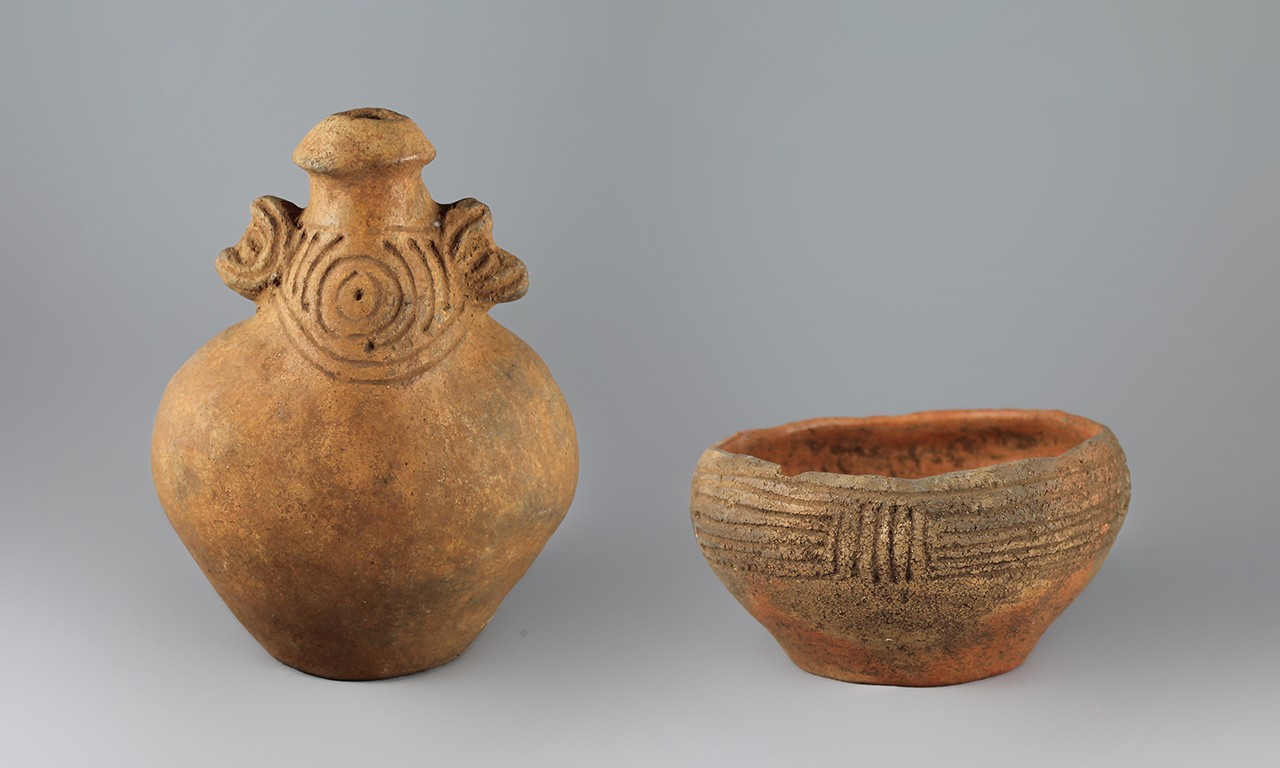 |
Vessel and Bowl, 1200-1500
Taíno culture; Dominican Republic
Ceramic
99.20.3,.16
Gift of Mr. and Mrs. Warren and Nancy Lampkin |
Indigenous Peoples’ Day
Several months ago, the Bowers Blog looked at two Taíno woodcarvings in the Bowers Museum’s collections. In the post we discussed how the culture was the first group to greet Columbus’ expedition and how, just on the island of Hispaniola in a span of 30 years, the population was reduced by one-third to one-tenth of its original size. While October 12 is still nationally marked as Columbus Day, many states including California now celebrate it as Indigenous Peoples’ Day, honoring the Native Peoples of the Americas as well as their histories and cultures. In today’s post we look at a group of ceramic objects made by the Taíno prior to the arrival of Columbus. Though our previous post focused principally on Taíno history, here we look at the significance of the motifs and forms used by the peoples of the Greater Antilles.
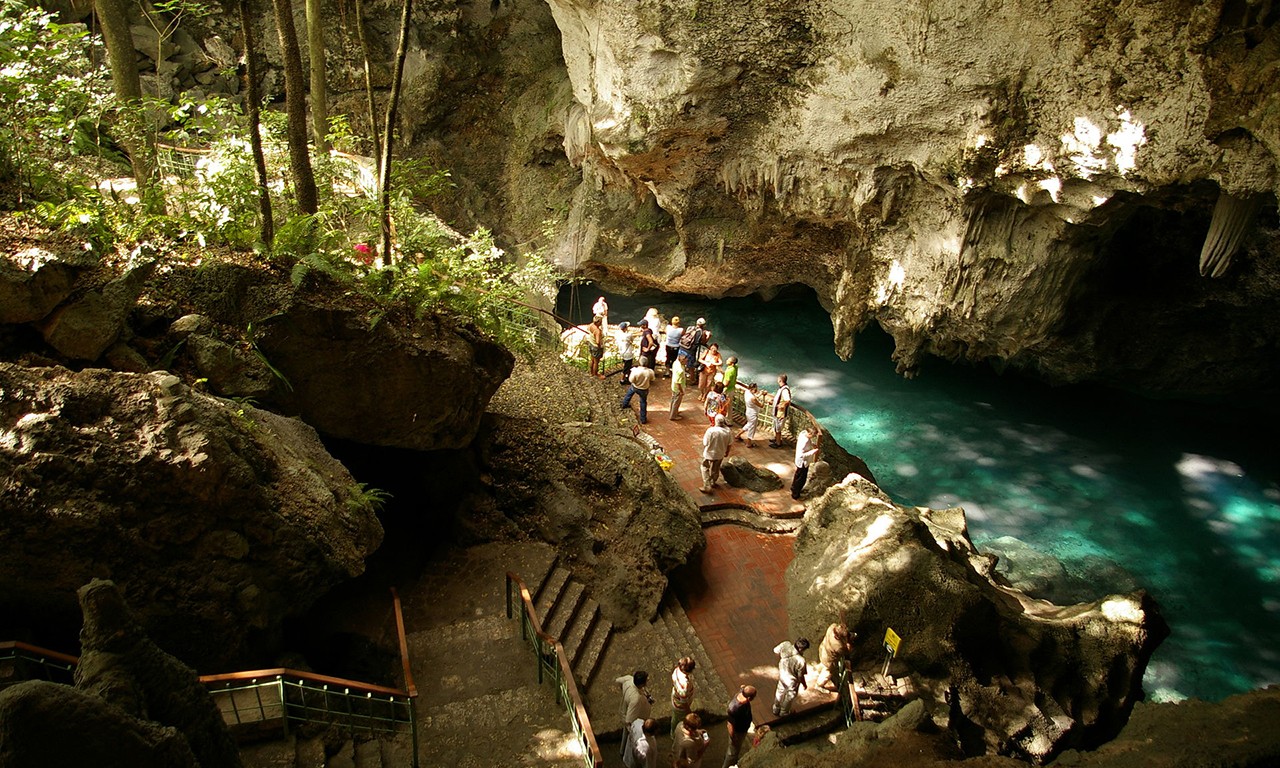 |
| Los Tres Ojos, a cave complex in the modern day city of Santo Domingo by Swatigsood, 2010 |
Well Pot-tected
As we discussed previously, the vast majority of Taíno art to survive the colonization of the Greater Antilles were objects that were either already used in caves as parts of rituals or were moved there following the arrival of Columbus to protect them. Dating as far back as the second century BCE, migrations of forerunners to the Taíno brought knowledge of pottery making to the Caribbean. Additional waves of migration served to further change the way that pottery was made until around 1000 CE, after which point the various cultures and groups are referred to by the umbrella term Taíno. The various subgroups that constituted the Taíno created a wealth of different pottery styles, though their earthenware as a whole can be characterized by commonly featuring abstracted anthropomorphic and zoomorphic figures with much of the supplemental decoration done as high-relief geometric linework.
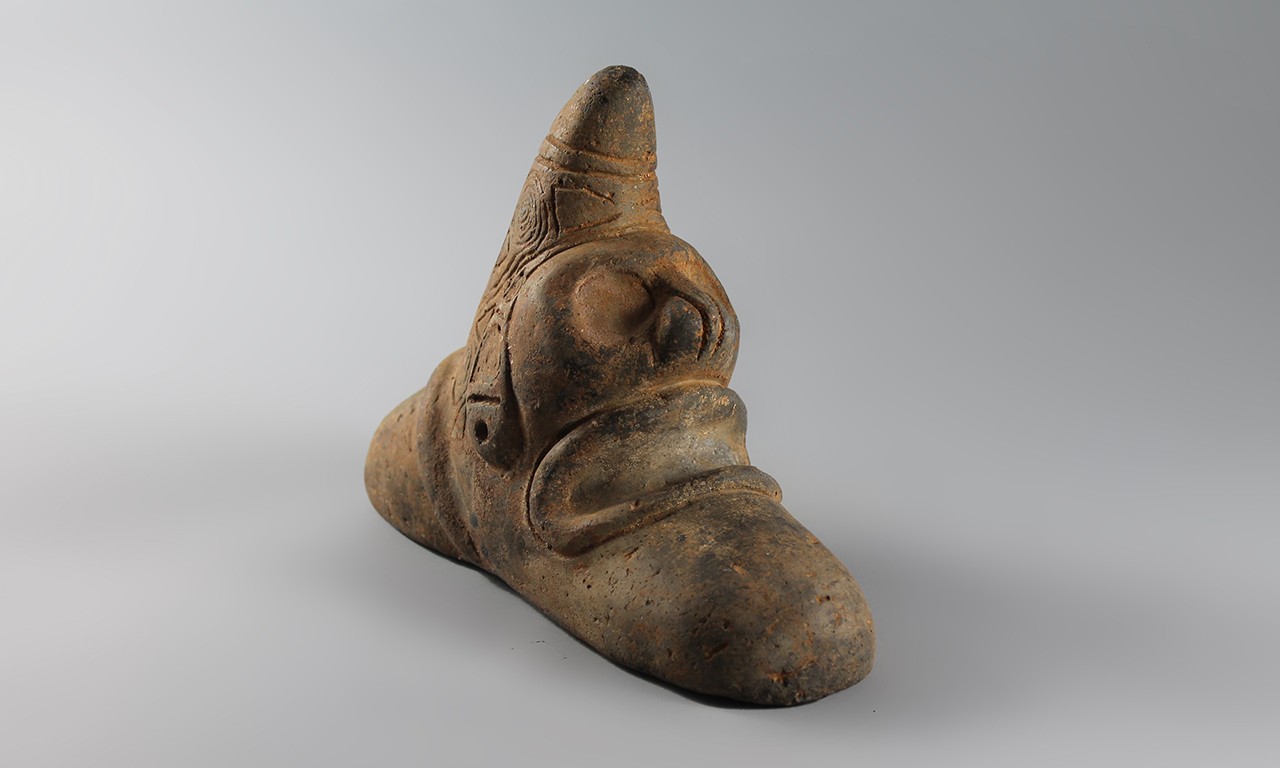 |
Three-Cornered Stone (Trigonolito), 1200-1500
Taíno culture; Dominican Republic
Ceramic; 5 1/2 x 2 1/2 x 8 in.
99.20.30
Gift of Mr. and Mrs. Warren and Nancy Lampkin |
Tricorned, Flat
One of the major complexities in studying Taíno art is the difficulty in determining the specific function of objects when there is no written record to help with doing so. A common method for the study of museum objects begins with a purely visual analysis, not relying on any prior knowledge or—certainly more prone to producing errors—assumptions. In looking at the above piece, what conclusions can we draw just by inspection? It is a three-pointed object with one semi-circular bar with an almost perfectly flat base forming a T-intersection with a triangular part of the object. This triangular section is sculpted on one side with a face and the other with geometric motifs. A flat base might indicate that an object had been used for pounding or pulverizing, but its shape would be unwieldy for that function. This discrepancy indicates that the object would have had some ceremonial purpose rather than a utilitarian one. Scholarship confirms that this trigonolito (three-pointed stone) were ritual objects representing the Taíno spirit of cassava, Yúcahu. They were often buried in farmland to assist in crop yields. That this piece is ceramic is unique, as trigonolitos tend to be made from stone.
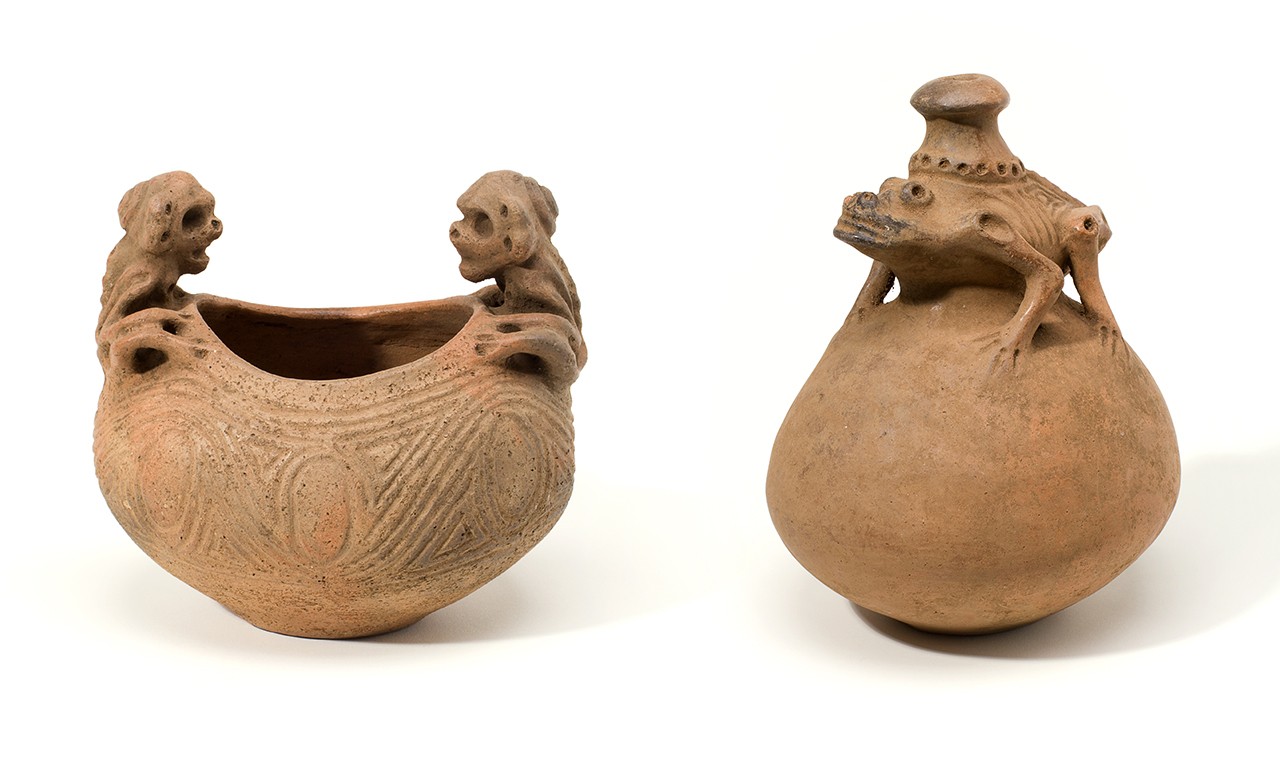 |
Jar and Bowl, 1200-1500
Taíno culture; Dominican Republic
Ceramic
2001.73.1-.2
Gift of Mr. and Mrs. Warren and Nancy Lampkin |
Shamanic Transformations
Most Taíno ceramics conform to more universal functions and forms. The above two objects are immediately recognizable as a vessel and bowl as are the two objects at the top of this post. However, due in part to the nature of how Taíno pieces have survived to the modern day, most bely some ceremonial function. In the case of the vessel and bowl just above it is their motifs that best illustrate this. Both show frogs, one skeletonized and one not. Frogs were symbols of fertility as well as transformation because they begin as water-based pollywogs and eventually grow into fully amphibious animals. Like frogs, shamans were believed capable of shape-shifting the form of their soul and traveling about in other realms and dimensions of being. The figures likely represent transformed shamans possibly undergoing an initiation. The dual male-frog imagery is an allusion to a shamanic motif appearing in a significant portion of figurative Taíno pottery.
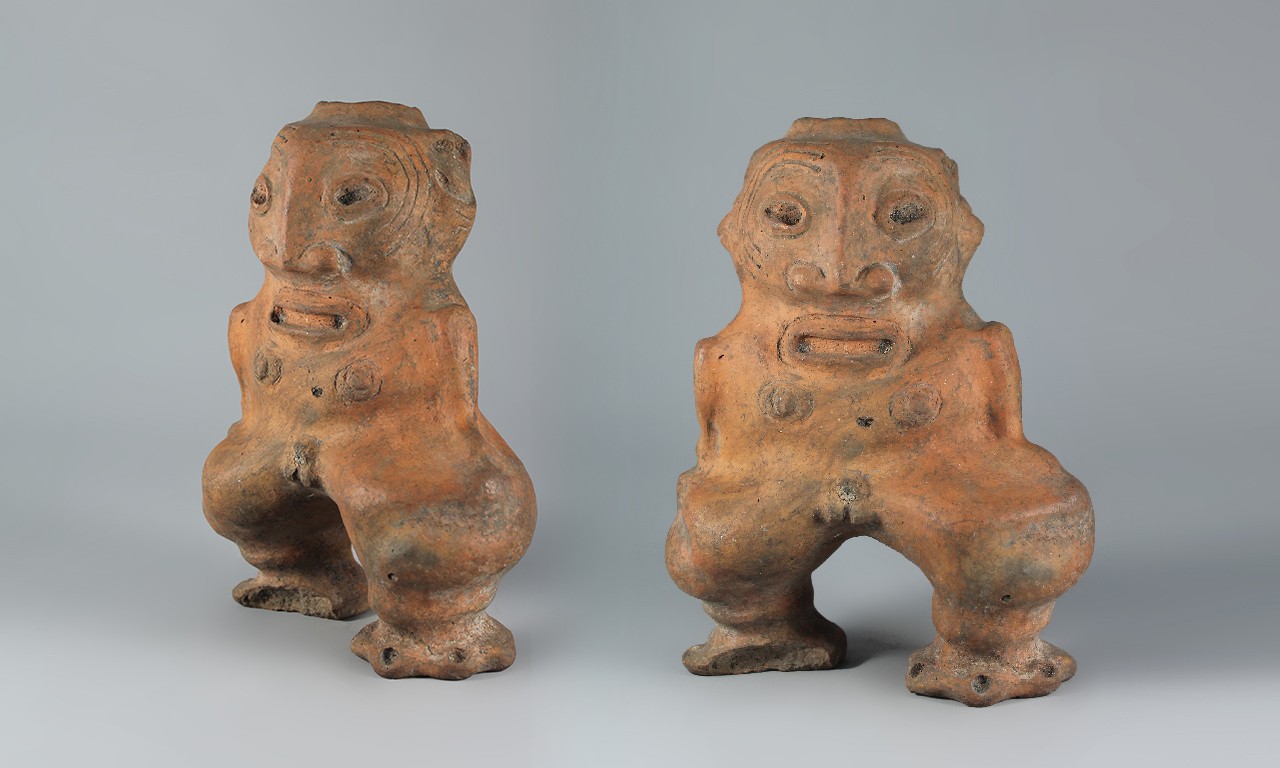 |
Dimivan Caracaracol Vessel, 1200-1500
Taíno culture; Dominican Republic
Ceramic; 9 1/4 x 7 x 3 1/2 in.
99.20.25
Gift of Mr. and Mrs. Warren and Nancy Lampkin |
Figure Half Full or Half Empty?
In addition to more recognizable pottery types the Taíno also created several forms that are almost entirely novel. These designs include a large two-chambered container and the above vessel in the form of a man. This latter form has been seen in several museum collections including the Smithsonian. It is unclear how many of these vessels exist, but the Smithsonian example depicts Dimivan Caracaracol, a mythological figure who asks the gods for cassava and instead receives a hearty smack to his back with a long rod. In the next few days, a turtle bursts forth from the wound. Though the Bowers Museum’s figural vessel does not bear markings of a growing shell, the back of the figure’s head has a series of nested ovals also seen on the reverse of the trigonolito, the significance of which is as of yet unknown.
The ceramic pieces in this post only survived to 2020 through the good fortune and foresight of the Taíno peoples of five centuries past. The ease with which these cultural legacies could have been lost to time shows the importance of celebrating the art and cultures of America’s Indigenous Peoples.
Text and images may be under copyright. Please contact Collection Department for permission to use. References are available on request. Information subject to change upon further research.






Comments 2
Hello,
I have recently been given several Taino ceramic fragments and am interested in properly cleaning them. As a low fired ware is it advisable to use the standard water a light touch toothbrush method?
Thank you for your time,
David
I found a fragment of pottery when I lived on St. Croix and was digging in the soil. It looks like it could be Taino…
Would anyone be interested in taking a look at it?